LEGGE HEADS ARMS BODY: top ten secrets of headlines that pull
If you are raising funds in any public medium your responses will directly relate to the effectiveness of your headline. A good headline can easily double or triple your response, and a great one can do even better – up to 17 times better, some say.
- Written by
- Ken Burnett
- Added
- June 26, 2012

The story that ran under the above headline explained that a certain Sir Thomas Legge had been appointed to lead an investigation into arms dealing in a West African country. A pretty dull story, really. But you’ve got to admit the headline writer must have enjoyed crafting that one and his or her efforts probably got a lot of people to read the text (I borrowed the headline from Fred MacAuley on BBC Radio 4’s News Quiz).
David Ogilvy believed that the number one secret to successful marketing copy is the headline. If it’s to succeed, any ad, press release, email, website announcement, newsletter or marketing document of any kind really needs to have a strong headline.
Ten keys to a successful headline
1. It has to have impact. The newsroom at the London Daily Express newspaper used to have a huge banner hung across it, which proclaimed IMPACT – GET IT IN YOUR HEADLINES. It’s not a bad idea to have a prompt like this – you might try it in your office. Impact works best when your words make people stop and think, or feel that they must know more.
2. Keep it short. A challenge this, but worth working at. Five words or fewer is best. But don’t sacrifice a great headline solely for brevity. Though if you are heading for double figures, maybe think again (NB there are a few exceptions to this, opposite).
3. Tell a story. Or at least, introduce intrigue. Long before Twitter came along, headline writers were constantly tasked to concisely communicate their message in many less than 140 characters. It’s a savage but exhilarating challenge.
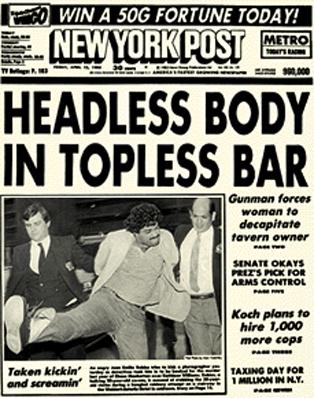
4. Make an offer in the headline. MAKE A BLIND MAN SEE. What a great thing to do! And you can, here, now. Offers grab attention.
5. Include a price. MAKE A BLIND MAN SEE. $20.00. If you can put a price on your proposition it answers the reader’s most obvious first objection. Now, where could anyone get better value for money than that? The rest of your fundraising message is now easy.
6. Your headline has to resonate. It must sound right when you say it out loud. Plays on words are good (see main headline, above and a few others around). Alliteration helps (as in ‘She sells sea shells by the sea shore’) but seems strangely out of favour these days. It is of course possible to be too clever, which can put potential buyers off. Generally, cleverness is to be avoided in fundraising ads. Go instead for passion, emotion and a direct call to action.
7. Don’t punctuate. Or rather, punctuate carefully and sparingly. Ogilvy pointed out that the full point at the end of a sentence indicates to readers that they should stop. So a full point at the end of a headline can cause people to stop reading your message, particularly when they are flicking through a newspaper, scanning for what interests them. If an intriguing headline will encourage them to read on, it shouldn’t ever be stopped dead by a full point. Full stop. It also makes sense to ensure your text is easily readable, though this is more of an issue with longer (ie body) copy.
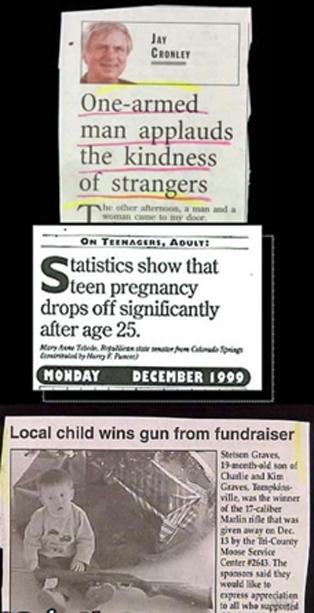
8. Observe reading gravity. Most people (ie most languages) naturally read top left to bottom right. There are several exceptions that read right to left, including Hebrew, Arabic, Japanese, Chinese, Farsi, Pashtu and Urdu. But English and most European languages are read top left to bottom right. So anything that goes against this will be resisted. Logically therefore all advertisements should follow what’s known as the Ayer no 1 format – picture at top, captioned as necessary (the eye is attracted first to the pic, then reads down) with headline below, then body copy (the sales pitch) below that, which leads persuasively into the reply coupon at the bottom (outside fore edge and foot, preferably, for easy access to the coupon). Other layouts than the Ayer no 1 might look pretty, but they will fight against what’s comfortable for readers.
9. Allow your headline enough space. Most so-called communicators these days try to say too much, so they cut their pictures and headlines to make room for their excess words. So, most headlines lose impact or even get lost entirely, because they are too small. One third pic/ one third headline/ one third text used to be the rule. Maybe for fundraisers it would be four quarters, to include the reply coupon.
10. Copy what others do. The best way to come up with your great headline is to copy those used by others, particularly the very successful. In direct response advertising you can recognise the most successful headlines because they appear again and again. If a headline only appears once or twice you are probably seeing a test that didn’t work.
Here are a few worth pondering.
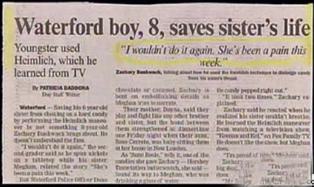
SUPER CALEY GO BALLISTIC, CELTIC ARE ATROCIOUS.
It doesn’t exactly trip off the tongue, but this headline from The Sun proves that the king of British red tops (tabloid newspapers seem all to have red banner headings, so are known as red tops) is difficult to beat when it comes to puns. It’s the classic formula: rip off a song lyric everyone knows, substitute a few words and stick it on the sports pages. Brilliant. Caley are my local top team, Inverness Caledonian Thistle, and Celtic are one of the top two Glasgow firms.
BRITANNIA WAIVES THE RULES
When the royal yacht HMS Britannia visited the West Indies she was given permission to dock in a port normally prohibited to ships of her size, which gave the headline writers a field day. The above reversal of words from the song makes an almost perfect headline.
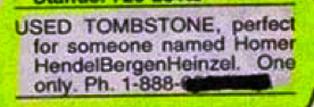
SINGING NUN IN DRUG SUICIDE PACT
Apparently The Sun also ran the above headline, though I haven’t been able to find it. Not something you would easily ignore though, is it?
FREDDIE STARR ATE MY HAMSTER
The ultimate intrigue headline (see above), only likely to be beaten when a hamster finally eats Freddie Starr. Headlines of the ‘man bites dog’ variety invariably go down well with the public.
If you have any suggestions for great headlines, or headlines that you think might be inspirational, innovative or merely instructive for SOFII readers, please let SOFII know by contacting Carolina.
Now, thanks to the wonders of the Internet, here are some headlines worth copying. The list below is borrowed from a website written by Jay Abrahams and has been edited for SOFII. Many of the headlines and qualifying comments seem rather dated now but we have left them in because there are some real nuggets of information here.

1. THE SECRET OF MAKING PEOPLE LIKE YOU
This drew many hundreds of thousands of readers into the body matter of the advertisement. Pretty irresistible, isn't it?
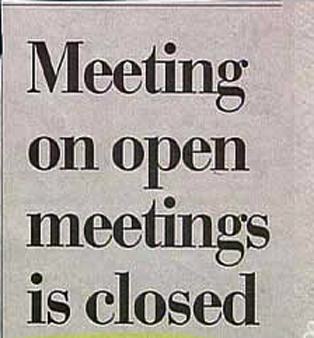
2. A LITTLE MISTAKE THAT COST A FARMER $3,000 A YEAR
Sometimes the negative idea of offsetting, reducing, or eliminating the ‘risk of loss’ is even more attractive to the reader than the ‘prospect of gain’.
A famous business executive once said, ‘I would not stay up all of one night to make $100; but I would stay up all of seven nights to keep from losing it.’ People will fight much harder to avoid losing something they already own than to gain something of greater value that they do not own. It is also true that they have the feeling that losses and waste can often be more easily retrieved than new profits can be gained.
What farmer could pass up reading the copy under such a headline, to find out: ‘What was the mistake? Why was it "little"? Am I making it? If it cost a farmer a loss of $3,000 a year, maybe it's costing me a lot more? Perhaps the copy will also tell me about other mistakes I might be making?’
3. ADVICE TO WIVES WHOSE HUSBANDS DON'T SAVE MONEY – BY A WIFE
The headline strength of the word ‘advice’ has often been proved. Most people want it, regardless of whether or not they follow it. And the particular ‘ailment’ referred to is common enough to interest a lot of readers. The ‘it happened to me’ tag line, ‘by a wife,’ increases the desire to read the copy. (This ad far outpulled the advertiser's previous best ad, Get Rid of Money Worries.)
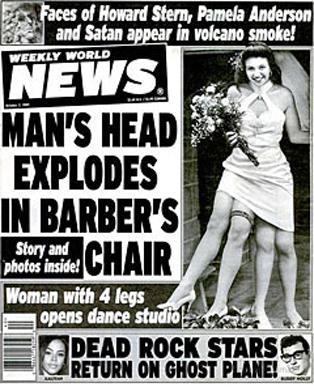
4. THE CHILD WHO WON THE HEARTS OF ALL
This ad proved spectacularly profitable when it appeared in women's magazines. The emotional-type copy described and the photograph portrayed the kind of little girl any parent would want their daughter to be. Laughing, rollicking, running forward with arms outstretched, right out of the ad and into the arms and heart of the reader.
5. ARE YOU EVER TONGUE-TIED AT A PARTY?
Pinpoints the myriads of self-conscious, inferiority-complexed wallflowers. ‘That's me! I want to read this ad; maybe it tells me exactly what to do about it.’
As you go along, you will notice how many of these headlines are interrogative ones. They ask a question to which people want to read the answer. They excite curiosity and interest in the body matter that follows. They hit home and cut through verbose indirectness. The best ones are challenges, which are difficult to ignore, cannot be dismissed with a quick no or yes and without further reading, are pertinent and relevant to the reader. Note how many of the ones included here measure up to these specifications.
6. HOW A NEW DISCOVERY MADE A PLAIN GIRL BEAUTIFUL
Wide appeal; there are more plain girls than beautiful ones – and just about all of them want to be better looking.
7. HOW TO WIN FRIENDS AND INFLUENCE PEOPLE
This helped to sell millions of copies of the book of the same title. Strong basic appeal; we will all want to do it. But without the words ‘how to’ the headline would become simply a trite wall motto.
8. THE LAST 2 HOURS ARE THE LONGEST – AND THOSE ARE THE 2 HOURS YOU SAVE
An airline ad featured a faster jet-powered flight. This headline is a bull's-eye for experienced air travellers who know what those last two interminable hours can do to their nerves and patience. Like many fine headlines, it doubtless came right out of the personal experience of its writer. This headline (and all the others discussed here) would have been good even if it had not been supported by any picture at all. But its effect was heightened by a photo of a wristwatch with the hour marks indicating 1 to 10 bunched together – and 10, 11, and 12 stretched wide apart.
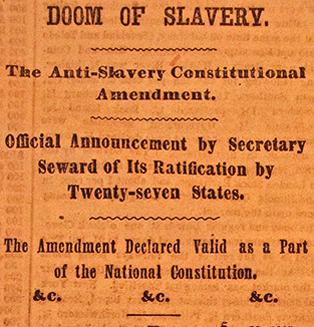
9. WHO ELSE WANTS A SCREEN STAR FIGURE?
Who doesn't? Except men, and this successful and fun ad is not addressed to them. ‘Who else’ also has a ‘get on the bandwagon’ connotation: not ‘Can it be done?’ but ‘Who else wants to have it?’
10. DO YOU MAKE THESE MISTAKES IN ENGLISH?
A direct challenge. Now read the headline back, eliminating the vital word ‘these.’ This word is the ‘hook’ that almost forces you into the copy. ‘What are these particular mistakes? Do I make them?’ Also notice (as with many of the other headline reviewed) that this one promised to provide helpful personal information in its own context, not merely ‘advertising talk’.
Remember how significant a part the ‘specific’ plays in so many good headlines. It appears in many of our first ten. And in a surprising number of the next ninety. You will see how magnetically it helps to draw the reader into the body matter of an advertisement. So notice, as you continue reading, how many of these headlines contain specific words or phrases that make the ad promise to tell you: how, here's, these, which of these, who else, where, when, what, why. Also, note frequently exact amounts are used: number of days, evenings, hours, minutes, dollars, ways, types of. This ‘attraction of the specific’ is worth your special attention – not only as relating to words and phrases, but also concerning headline ideas themselves. For example, compare the appeal of ‘We'll help you make more money’ with ‘We'll help you pay the rent.’
11. WHY SOME FOODS ‘EXPLODE’ IN YOUR STOMACH
A provocative ‘why’ headline. Based upon the completely understandable fact that some food combinations virtually ‘explode’ in the stomach. Broad appeal. (Relevant picture of chemical retort shaped like a stomach, starting to explode.)
12. HANDS THAT LOOK LOVELIER IN 24 HOURS – OR YOUR MONEY BACK
Universal appeal to women. Result guaranteed: ‘Or Your Money Back.’
13. YOU CAN LAUGH AT MONEY WORRIES – IF YOU FOLLOW THIS SIMPLE PLAN
Something everybody wants to be able to do. A successful keyed ad upon which many thousands have been spent.
14. WHY SOME PEOPLE ALMOST ALWAYS MAKE MONEY IN THE STOCK MARKET
A profitable ad selling a book written by a partner in a well-known and highly regarded brokerage house. Important key words: ‘some’ and ‘almost’ – which make the headline credible.
15. WHEN DOCTORS ‘FEEL ROTTEN’ THIS IS WHAT THEY DO
What's the secret of the success of this well-known ad? First: the suggestion of a paradox. We seldom think of doctors as being in poor health themselves. And when they are, what they do about it is information ‘right from the horse's mouth’; it carries a note of authority and greater assurance of ‘reward for reading the ad’. Note the positive promise of reward in ‘This Is What They Do’.
Also, the use of the unabashed colloquialism ‘feel rotten’ gets attention, sounds human, natural. Besides, it has surprise value – since the vocabulary of the advertising pages has a certain sameness and stilted quality. Many a headline fails to stop readers because its vocabulary is so hackneyed. No word or phrase in it has any attention-arresting element of surprise, no words, expressions, or ideas not commonly used or expected in the headline of an advertisement. This ad pulled only half the number of responses when a test was made changing ‘When Doctors Feel Rotten’ to ‘When Doctors Don't Feel Up To Par’.
16. IT SEEMS INCREDIBLE THAT YOU CAN OFFER THESE SIGNED ORIGINAL ETCHINGS – FOR ONLY $5 EACH
Anticipates the reader's natural incredulity concerning such an exceptional bargain. Thus helping to overcome his doubt in advance, by acknowledging the likelihood of it.
17. FIVE FAMILIAR SKIN TROUBLES – WHICH DO YOU WANT TO OVERCOME?
‘Let me keep reading – to see if I have one of the five.’ The old ‘which of these’ selling technique; not ‘do you want?’ but ‘which do you want?’ Interrogative headline helps entice readers into the copy. Note how many of these hundred are interrogative headlines.
18. WHICH OF THESE $2.50 TO $5 BEST SELLERS DO YOU WANT – FOR ONLY $1 EACH?
This keyed ad sold hundreds of thousands of books. Strong comparative-price bargain appeal.
19. WHO EVER HEARD OF A WOMAN LOSING WEIGHT – AND ENJOYING 3 DELICIOUS MEALS AT THE SAME TIME?
Another example of a headline that anticipates incredulity in order to help overcome it.
20. HOW I IMPROVED MY MEMORY IN ONE EVENING
This is the famous ‘Addison Sims of Seattle’ ad, which coined that household phrase. Could you escape wanting to read it?
21. DISCOVER THE FORTUNE THAT LIES HIDDEN IN YOUR SALARY
One of those good ‘discover what lies hidden’ headlines. A proven puller for an advertiser offering sound securities on a ‘pay out of income’ basis.
Abridged from
The 100 Greatest Headlines Ever Written
For the remaining 79 go to the author’s website.


















